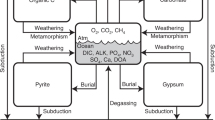Abstract
There has been life on Earth for at least 3,500 Myr but the assumption that a comparable future lies ahead may not be justified. Main sequence stars appear to increase their burning rate as they age. Thus the Sun, if a typical star, can be predicted to have increased its output by 30% since the Earth's origin 4,500 Myr ago1. The maintainance of an equable climate since life began probably required some means of planetary thermo-stasis. The Gaia hypothesis proposed by Lovelock and Margulis2 included an unspecified biological means for climate control. Walker et al.3 suggests an abiological automatic thermostasis in which the atmospheric abundance of CO2, a greenhouse gas, adjusts to resist the warming tendency of the increased solar flux. Here we discuss possible links between the biological and geological control mechanisms. It is clear that whatever the mechanism, atmospheric CO2 is now close to its lower limit of partial pressure, so the biosphere may soon, in geological terms, be exposed without protection to the predicted progressive increase of solar luminosity.
This is a preview of subscription content, access via your institution
Access options
Subscribe to this journal
Receive 51 print issues and online access
$199.00 per year
only $3.90 per issue
Buy this article
- Purchase on Springer Link
- Instant access to full article PDF
Prices may be subject to local taxes which are calculated during checkout
Similar content being viewed by others
References
Newkirk, G. Jr. Geochim. cosmochim. Acta Suppl. 13, 293 (1980).
Lovelock, J. E. & Margulis, L. Tellus 26, 1 (1974).
Walker, J. C. G., Hays, P. B. & Kasting, J. F. J. geophys. Res. (in the press).
Owen, T., Cess, R. D. & Ramanathan, V. Nature 277, 640 (1979).
Sagan, C. & Mullen, G. Science 177, 52 (1972).
Henderson-Sellers, A. & Schwarz, A. Nature 287, 526 (1980).
Wigley, T. M. L. & Brimblecombe, P. Nature 291, 213 (1981).
Henderson-Sellers, A., Benlow, A. & Meadows, A. J. Q. Jl R. astr. Soc. 21, 74 (1980).
Brock, T. D. Science 158, 1012 (1967).
Bolin, B., Degens, E. T., Kempe, S. & Ketner, P. The Global Carbon Cycle, SCOPE Rep. 13 (Wiley, New York, 1979).
Holland, H. D. The Chemistry of the Atmosphere and Oceans (Wiley, Chichester, 1978).
Baes, C. F. in Carbon Dioxide Review 1982 (ed. Clark, W. C.) (Institute of Energy Analysis, Oak Ridge Associated Universities, Tennessee, 1982).
Gough, D. in The Solar Output and its Variation (ed. White, O. R.) 451 (Colorado Associated University Press, 1977).
Steiner, J. & Grillmair, E. Bull. geol. Soc. Am. 84, 1003 (1973).
Harland, W. B. & Herod, K. N. in Ice Ages Ancient and Modern (eds Wright, A. E. & Moseley, F.) (Seal House, Liverpool, 1975).
Henderson-Sellers, A. Nature 279, 786 (1979).
Hart, M. H. Icarus 33, 23 (1978).
Author information
Authors and Affiliations
Rights and permissions
About this article
Cite this article
Lovelock, J., Whitfield, M. Life span of the biosphere. Nature 296, 561–563 (1982). https://doi.org/10.1038/296561a0
Received:
Accepted:
Published:
Issue Date:
DOI: https://doi.org/10.1038/296561a0
This article is cited by
-
Ecocentrism and Biosphere Life Extension
Science and Engineering Ethics (2022)
-
The future lifespan of Earth’s oxygenated atmosphere
Nature Geoscience (2021)
-
Solar structure and evolution
Living Reviews in Solar Physics (2021)
-
The emergence and evolution of Earth System Science
Nature Reviews Earth & Environment (2020)
-
Impact of Fall Armyworm on Farmer’s Maize: Systemic Approach
Systemic Practice and Action Research (2020)
Comments
By submitting a comment you agree to abide by our Terms and Community Guidelines. If you find something abusive or that does not comply with our terms or guidelines please flag it as inappropriate.



